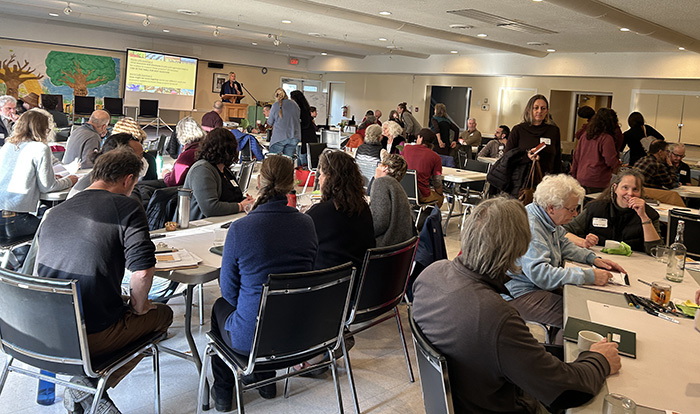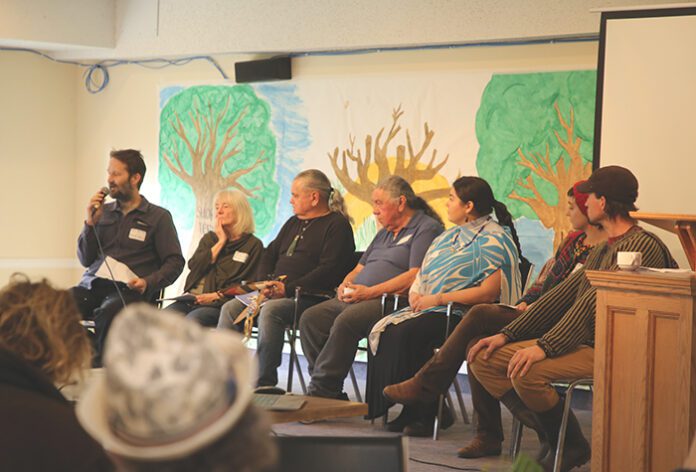About 80 people feasted on a homegrown initiative at the Salt Spring Island Food Summit held Nov. 26 at Meaden Hall, hoping to spark revolutionary change when it comes to the amount of local food available to islanders.
The brainchild of writer and film/TV producer Jon Cooksey, who with his partner Pam Tarr has immersed himself in the food-growing potential of a Salt Spring property they bought a few years ago, the summit’s aim was to find ways to increase local food production from the current four to six per cent level and make the island more resilient in the face of climate change.
Many summit attendees were those with their hands in the soil or connected to food-producing endeavours, but the roster also included local government representatives and people involved with impactful businesses or non-profits. Everyone contributed to the discussion about possibilities and priorities.
First Nations summit participants provided a longer-view perspective, illustrating that our region’s lands and oceans had in the past provided an abundance of food and important trading commodities.
Maiya Modeste, the Garry oak ecosystems restoration coordinator for the Stqeeye’ Learning Society and keynote speaker, spoke of how the camas bulb, a staple food for her Quw’utsun ancestors, was traded up and down the coast and inland.
“It’s a way that we’ve connected with each other for thousands and thousands of years, and my goal, my dream in this life, is to be able to start those connections again, to go up and down, north and south, and share this story, and to revitalize this food system for our youth.”
Tsawout First Nation elders and knowledge keepers on a Projects for Action Panel also touched on reinvigorating traditional food sources. Earl Claxton, Jr. spoke of salmon once being part of his people’s daily diet, and his current activities of growing berry plants and transplanting them at Todd Inlet. Lorne Underwood shared the importance and challenges of projects such as clam garden restoration.
Anne Macey, of the Salt Spring Agricultural Alliance and other key groups, and John Pattinson of Bright Farm introduced the “50 Farms” concept that would see development of farms across the island, using the Capital Regional District Emergency Program’s neighbourhood pod grid as a guide.
“Leveraging from that pod system helps us have an organizational structure,” said Pattinson, “and so in the case of an emergency or food insecurity events, you’d have a way to access or know where your closest farm is.”
Nick Adamson-Jones, who with Polly Orr has coordinated a Grow Local project for the past two years, described recent activities related to gleaning — the harvesting of fruit trees or wild foods that are not otherwise tended — and to neighbourhood food production through community gardens.
“There are some beautiful models and inspiring projects that are already happening in that realm,” he said.
Joanna Ashworth, director of Professionals Programs and Partnerships in the Faculty of Environment at Simon Fraser University, provided facilitation for the day; and summit committee member Tarah Stafford prepared a delicious buffet lunch (made with approximately four per cent local foods).
Fuelled by lunch and the words of the morning’s presenters, event participants brainstormed ideas that ultimately led to nine project areas inviting development and commitment to work on them as soon as possible. (See sidebar, below.)
Summit sponsors and donors included the Salt Spring Island Foundation, the Institute for Sustainability, Education and Action, the Simon Fraser University Initiative Funds (through the Grow Local program), Salt Spring Coffee, Hen & Hound, Country Grocer, Heyday Farm (sponsored by Island Natural Growers), Jane Squier at The Garden, numerous home bakers, the Agricultural Alliance, Salt Spring Island Farmland Trust and Transition Salt Spring.
Cooksey described the summit as “just the beginning of a revolutionary change in how we work together on Salt Spring,” noting how the connections made that day were key to the actions that would be undertaken as a result.
A shared intention and believing that things can change are also crucial, he said in his closing remarks, which concluded with a lighthearted note.
“We have to each decide if we want to be part of a different future than the one that’s heading our way. So I think that takes sharing one intention, which is to feed the people of this place with food from this place, because this place and our friendships are what connect us. So we look forward to collaborating with you and becoming one big systemic family and, if I may say so, I believe in you, and I believe in dinner.”

Nine Projects Selected
From small-group discussions at the Nov. 26 Salt Spring Island Food Summit came nine areas of focus, with participants signing up to spend time on one or more of them in the near future.
• 50 Farms – an initiative to make local farming more cooperative and financially stable, increase community connections to farmers, mentor and support new farmers, and integrate food security with emergency preparedness.
• Grow Local – supporting bottom-up food growing and gathering initiatives at the neighbourhood and island-wide level.
• Indigenous Collaboration & Marine Foods – bringing together all who are connected to this land and these waters, indigenous and settler, to solve the obstacles to boosting food abundance, resilience and sovereignty for all, with a particular focus on marine foods.
• Forest Food & Native Plants – support for the restoration work being done in Xwaaqw’um (Burgoyne Bay) by the Stqeeye’ Learning Society, with a focus on bringing camas and other native plants back into our regional food supply.
• Youth-focused Programs – including education, support, resources and work experience for youth relating to food production.
• Shared Resources – creating a system of sharing food-related resources from information to mentoring to tools and equipment.
• Public Engagement – bringing everyone on Salt Spring together over the joy of food and its benefits for our health, our resilience and our community bonds.
• The Business of Food – improving the economics of our food system, ensuring supply chain stability and providing capital for boosting food production, processing and distribution.
• Food Security Coordinating Committee – providing systemic coordination and planning between the other projects, possibly in liaison with a paid food security coordinator for the island.


I wished I had known about this, was it advertised anywhere? This is crucial to do this.
Hi Susan — It was a by-invitation event with people representing different sectors. More public engagement and activities will arise from it.